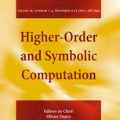The field of Artificial Intelligence (AI) has undoubtedly received significant attention in recent years. AI is being adopted to provide solutions to problems in fields such as medicine, engineering, education, government and several other domains. In order to analyze the state of the art of research in the field of AI, we present a systematic literature review focusing on the Evolution of AI programming languages. We followed the systematic literature review method by searching relevant databases like SCOPUS, IEEE Xplore and Google Scholar. EndNote reference manager was used to catalog the relevant extracted papers. Our search returned a total of 6565 documents, whereof 69 studies were retained. Of the 69 retained studies, 15 documents discussed LISP programming language, another 34 discussed PROLOG programming language, the remaining 20 documents were spread between Logic and Object Oriented Programming (LOOP), ARCHLOG, Epistemic Ontology Language with Constraints (EOLC), Python, C++, ADA and JAVA programming languages. This review provides information on the year of implementation, development team, capabilities, limitations and applications of each of the AI programming languages discussed. The information in this review could guide practitioners and researchers in AI to make the right choice of languages to implement their novel AI methods.
翻译:近些年来,人工智能(AI)领域无疑受到高度重视,通过人工智能(AI)领域无疑受到高度重视,通过人工智能为医学、工程学、教育、政府和其他几个领域的问题提供解决办法,为了分析人工智能领域的研究水平,我们提交了一份系统的文献审查,重点是AI编程语言的演进;我们通过搜索SCOPUS、IEEE Xplore和Google学者等相关数据库,采用了系统文献审查方法,搜索了SCOPUS、IEEE Xplore和Google学者等相关数据库;使用端注参考管理员将相关摘录的论文编集成目录;我们搜索了总共6,655份文件,其中保留了69份研究报告;在保留的69份研究报告中,15份文件讨论了LISPLIS编程语言,另外34份文件讨论了PROLOG编程语言,其余20份文件在LOOP(LOOP)、LOOG、ARCHLOG、EONGOIP、EPITEOTIONE Ontologic语言(ELAC)、ELC)、EXONTONAT、EXONTUA+ADADA和JAVAVA和JAVAVAVAVAVA和JAVAVAVA编程语言(O)之间传播语言(E)之间分发指南语言(EDADA),本中,本审评员可使用新方法),本审查者指南,本中,可使用新方法。本审查的研究人员和研究人员和研究人员可使用新方法。本审查。本指南。本节中,可使用新方法。本中可使用。本指南。本节中可使用新方法。本。本节中,可使用。本指南。本。本节中可使用新方法。





